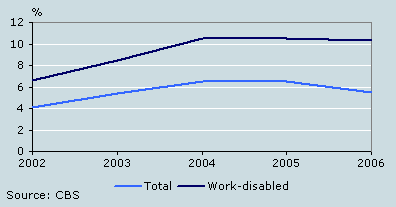Work-disabled hardly benefit from thriving economy

If the situation on the labour market deteriorates, work disabled individuals are hit harder than the population as a whole. Reversely, in times of economic recovery, work-disabled persons benefit less than average.
Labour participation disabled stalling
In 2006, there were more than 1.7 million people in the Netherlands with work disabilities, i.e. 16 percent of all people aged between 15 and 65 (the total labour force). Nearly 40 percent of people with work disabilities had paid jobs of 12 hours a week or more in 2006. With 65 percent, the labour participation rate is distinctly higher for the labour force as a whole.
In 2006, economic recovery was reflected in a marginally higher labour participation rate of the total labour force relative to one year previously. In the work-disabled labour force, however, there was no increase relative to 2005.
Work participation rate in the disabled and the total population aged between 15 and 65

Unemployment rate remains high among disabled
When the economic situation deteriorates, a similar trend can be observed. In the period 2002-2005, for example, unemployment in the Netherlands rose from 4.1 to 6.5 percent. Among people with work disabilities, the unemployment rate rose from 6.6 percent in 2002 to 10.5 percent in 2005.
When the economy picked up in 2006, the overall unemployment rate declined instantly, whereas the unemployment rate in the disabled labour force remained more or less the same.
Unemployment in the disabled and in the total population aged between 15 and 65

Hendrika Lautenbach